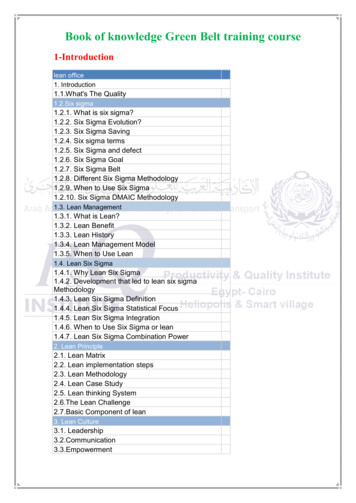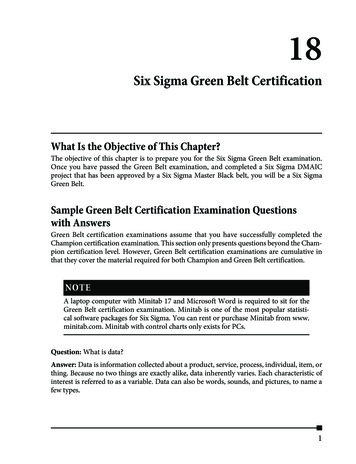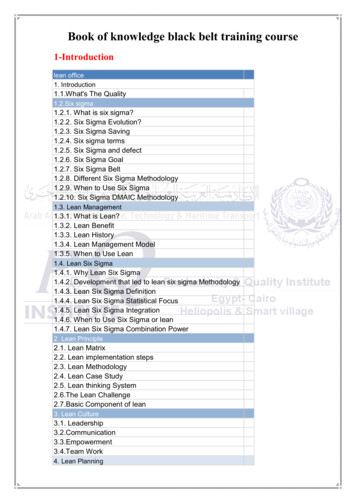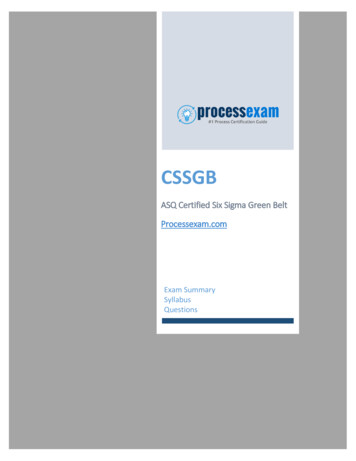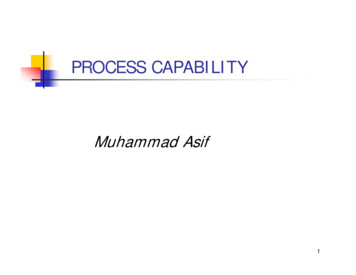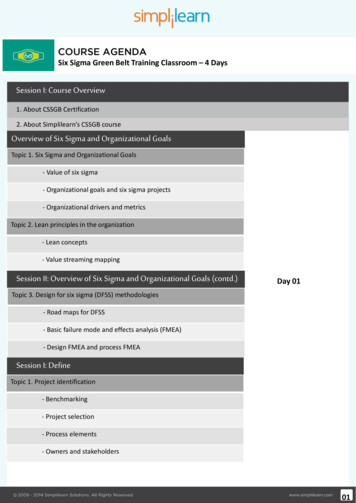
Transcription
SIX SIGMA green belt iIT 470aINSTRUCTOR:Dr. Tomas Velasco, C.Q.E., C.S.S.B.B.112C Engineering Building DCarbondale, IL 62901-6603 (618) 453-7842 VELASCO@engr.siu.eduTEXTBOOK:CSSGB PRIMER, Quality Council of Indiana,www.qualitycouncil.com, 2nd Edition.– (800) 660-4215.REFERENCES:BOOKS Implementing Six Sigma – Smarter Solutions Using StatisticalMethods by Forrest W. Breyfogle III, John Wiley & Sons, 2nd.Edition.
(FURTHER READING) Six Sigma Pocket Guide by Rath & Strong,Rath & Strong, Inc; Spiral edition (October 17, 2000). (FURTHER READING) What is Six Sigma by by Peter S. Pande,Larry Holpp, Pete Pande, Lawrence Holpp, McGraw-HillTrade; 1st edition (October 26, 2001).AUDIOVISUALS CLASS:Against all Odds: Inside Statistics Series, 1988Fall Semester 20138:00 am. – 9:15 am; Tuesday & Thursday219 ENG-AObjective:The purpose of this course is to provide the student with a comprehensive coverage of the basic techniques, tools,and applications of the “Six Sigma” methodology at the green-belt level focusing on developing the framework thatconstitutes the Six Sigma philosophy.Requirements:Major emphasis will be placed on reading and understanding the material from the class, suggested books andreference material prior to class, and in homework assigned. Class attendance is required.
Grading: 3 Examinations, each of which counts 25% of your grade.Last examination: Tuesday, December 10, from 7:50am to 9:50am.Homework, Work in Groups, and Quizzes, which count 25% of your grade.Standards:Letter grades are assigned based on the total number of points accumulated. A : 90% and higher B : 80% - 89.99% C : 70% - 79.99% D : 60% - 69.99% F : Less than 60%Office Hours:9:30 to 11:00 a.m. Tuesday & Thursday; 2:00 to 3:30 p.m. Monday and Wednesday; other hours by appointment.Equipment and Software:Hand-held calculator and any computer-based spreadsheet.Engineering.Excel is available in all the P.C. laboratories inLate Work Policy:Missed examinations and assignments have a 10% penalty per day, imposed when turned in, unless an appropriate,prior excuse is provided to the instructor. The missed examination must be completed on the make-up date set bythe instructor.Academic Conduct / Student Code of Conduct:Cheating on examinations, submitting work of other students as your own, or plagiarism in any form will result inpenalties ranging from an F on the assignment to expulsion from the university, depending on the seriousness of theoffense. Please refer to the following sites for information on the SIU’s student code of conduct and Morris Library’sguide on plagiarism: SIU Student Code of onductCodeFINALMay32011.pdf Morris Library Guide on Plagiarism: http://libguides.lib.siu.edu/plagiarismEmergency Procedures:Southern Illinois University Carbondale is committed to providing a safe and healthy environment for study andwork. Because some health and safety circumstances are beyond our control, we ask that you become familiar withthe S.I.U.C. Emergency Response Plan and Building Emergency Response Team (BERT) program. Emergencyresponse information is available on posters in buildings on campus, available on the BERT’s website at
www.bert.siu.edu, Department of Public Safety’s website www.dps.siu.edu (disaster drop down) and in theEmergency Response Guidelines pamphlet. Know how to respond to each type of emergency.Instructors will provide guidance and direction to students in the classroom in the event of an emergency affectingyour location. It is important that you follow these instructions and stay with your instructor during an evacuation orsheltering emergency. The Building Emergency Response Team will provide assistance to your instructor inevacuating the building or sheltering within the facility.SIU Policy on Incomplete GradesAn INC is assigned when, for reasons beyond their control, students engaged in passing work are unable to completeall class assignments. An INC must be changed to a completed grade within a time period designated by theinstructor but not to exceed one year from the close of the term in which the course was taken, or graduation,whichever occurs first. Should the student fail to complete the course within the time period designated, not toexceed one year, or graduation, whichever occurs first, the incomplete will be converted to a grade of F and thegrade will be computed in the student’s grade point average. Students should not reregister for courses in which anINC has been assigned with the intent of changing the INC grade. Re-registration will not prevent the INC frombeing changed to an F.Mobile Technology PolicyStudents may use laptops, tablets, netbooks, e-readers during class time but smart-phones should be off during theduration of the class. No electronic device should be used during a test, except a calculator.Inclusive ExcellenceSIU contains people from all walks of life, from many different cultures and sub-cultures, and representing all strataof society, nationalities, ethnicities, lifestyles, and affiliations. Learning from and working with people who differfrom you is an important part of your education in this class, as well as an essential preparation for any career.Resources for Academic AssistanceLearning Support Services: http://tutoring.siu.edu/ Provides academic assistance in courses/tutoringDisability Support Services: http://disabilityservices.siu.edu/ Provides the required academic and programmatic support services to students withpermanent and temporary disabilitiesSIUC Writing Center: http://write.siu.edu/ Offers free tutoring services to all SIUC undergraduate and graduate students and faculty.SIU Email PolicyOfficial SIU Student Email Policy: http://policies.siu.edu/policies.email.htmSIU Student Conduct Code: deFINALMay32011.pdf
Saluki CaresThe purpose of Saluki Cares is to develop, facilitate and coordinate a university-wide program of care and supportfor students in distress. By working closely with faculty, staff, students and their families, SIU Carbondale continuesto display a culture of care by demonstrating to our students and their families that they are an important part of thecommunity. To make a referral to Saluki Cares click, call, or send: http://salukicares.siu.edu/index.html, (618) 4535714, or siucares@siu.edu.Major Topics: Six Sigma and the organization (Goals and Definition) – Chapter IILean & DFSS – Chapter IIIDefine Phase (Teams & Customers) – Chapter IVDefine Phase (Projects, Tools & Results) – Chapter VMeasure Phase (Data & Process Analyisis) – Chapter VIImprove Phase – Chapter X (pp. X-2 to X-7)Minimum Student Competencies: Recognize why organizations use six sigma.Recognize key drivers for business.Understand the project selection process.Define and describe all concepts and tools in Lean Manufacturing.Describe how QFD fits into the overall DFSS.Describe and distinguish between DFMEA and FMEA.Describe and distinguish between DMADV, IDOV, and relation to DMAIC.Identify process owners, internal and external stakeholders.Use various methods to collect customer information.Use graphical and statistical methods to analyze data,Define and describe elements of a project in the Define phase.Define project metrics for a project.Use project management tools (Gantt, CPM, PERT)Use planning tools (affinity diagrams, interrelationship graphs, tree diagrams, prioritization matrices,matrix diagrams, PDPC charts, activity network diagrams.Calculate process performance matrices.Describe and define the roles and responsibilities of participants in a Six Sigma ProgramDefine and apply team tools (Brainstorming, Nominal group technique, multi-voting)
Develop and review process analysis tools (Process maps, Written procedures, Work instructions,Flowcharts)Identify variables for a SIPOC chartDocument variable relationships through Cause & Effect diagrams and Relational matrices.Distinguish between descriptive and inferential statistics.Define the central limit theorem and describe its significance.Define basic probability concepts (independence, mutually exclusive, AND, OR statements)Identify and classify continuous and discrete variablesDefine and apply methods for collecting data (Check Sheets)Define and apply techniques for data accuracy (random sampling, stratified sampling, samplehomogeneity)Define, compute and interpret measures for centrality and dispersion.Depict relationships by constructing and interpreting diagrams and charts (Histograms, Stem & Leaf Plots,Box Plots, Run Charts, Scatter Diagrams, Pareto Charts)
and applications of the “Six Sigma” methodology at the green-belt level focusing on developing the framework that constitutes the Six Sigma philosophy. Requirements: Major emphasis will be placed on reading and understanding the material from the class, suggested books and ref
